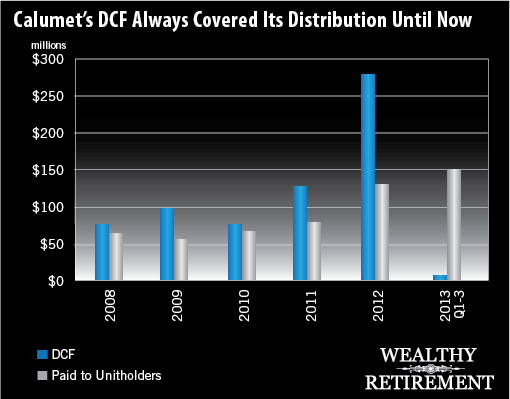 In honor of the Indianapolis Colts’ unbelievable comeback on Saturday, we’ll stay in Indy and examine the safety rating of Indianapolis-based Calumet Specialty Products Partners L.P. (Nasdaq: CLMT).
In honor of the Indianapolis Colts’ unbelievable comeback on Saturday, we’ll stay in Indy and examine the safety rating of Indianapolis-based Calumet Specialty Products Partners L.P. (Nasdaq: CLMT).
Calumet processes oil into products such as lubricants, solvents, asphalts, etc. It also turns oil into fuels such as jet fuel and gasoline.
The stock has a huge yield, currently 10.3%. The company is organized as a master limited partnership (MLP).
MLPs offer investors a tax benefit in that most of the cash distribution (MLPs pay distributions not dividends) is considered a return of capital and is not taxed in the year the distribution is received.
[ad#Google Adsense 336×280-IA]For more on MLPs, you can read my column here and scroll down to Step 3.
Calumet has a good history of annual distribution raises.
The company became public in 2006 and doubled its initial distribution by the end of 2007.
However, once the Great Recession hit, the company lowered its distribution to $0.45 per quarter from $0.63.
It remained at $0.45 until January 2010, when the company started raising it quarterly by a half a cent.
Since October 2010, the company has raised the distribution each quarter until the most recent distribution, which stayed at $0.685.
Of the 31 quarters in which the company has paid a distribution, management raised the payout in 16 quarters and cut it once.
Now, let’s see if Calumet generates enough cash to pay that juicy 10% yield.
High Yield, High Risk
The most accurate measure of an MLP’s ability to pay its dividend is a cash flow metric called distributable cash flow (DCF).
In the third quarter, Calumet’s DCF was negative $16 million. (Cue the record-scratching music-stopping sound effect.)
Now, I don’t care about net income when it comes to MLPs. Cash flow is everything, and in the third quarter, Calumet did not generate any. In fact, cash flow was negative. This was due to high oil prices, which led to a decline in profit margins. Capital expenditures were also higher.
Management said that the fall in oil prices since the summer has eased the pressure on margins.
I’m not a short-sighted Wall Street guy. Generally, I don’t worry about one quarter, though a quarter like this certainly raises my antennae.
What does worry me is the company has barely generated any cash flow for the entire year.
Despite sales being up 22% through the first nine months, DCF is a paltry $7.9 million. That compares with $226.6 million last year.
Through three quarters of 2013, the company distributed $149 million back to unitholders (MLPs have unitholders, not shareholders).
The company has plenty of cash – over $600 million and that’s before another $375 million was raised in November. But I want to see a company make enough money from running its business to pay the dividend (distribution)… not have to dip into its cash reserves.
You can see that in the past, the company has always generated more than enough cash to pay the distribution.

I’m not convinced that will be the case going forward. If the company was this badly affected by a spike in oil prices, what happens if prices jump again?
The fact that current DCF does not cover the distribution worries me. So does the fact that the company stopped its quarterly boost of distributions and has cut it once before.
After seeing Colts QB Andrew Luck lead his team to a dramatic comeback, I wouldn’t be surprised if the Colts go all the way. I’m not convinced I can say the same thing about Calumet Specialty Products Partners.
Dividend Safety Rating: D
— Marc Lichtenfeld
[ad#wyatt-income]
Source: Wealthy Retirement

